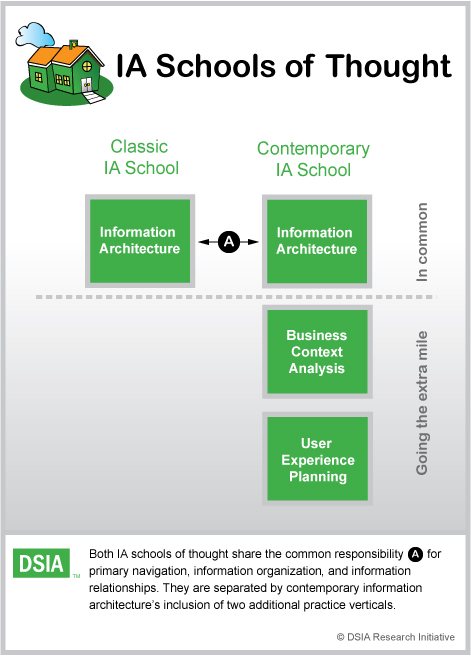While the book was ground breaking in its time and is still relevant today, the polar bear book never claimed to have all the answers. So, it was natural that numerous books by other authors—both academics and practitioners—hit the market in an attempt to fill the gaps and answer the questions that remained. While practical methods and approaches abound, educators have fallen short in conveying the basic aims of information architecture with clarity.
Fortunately, clients hire IA practitioners to do what they do rather than explain what they do. But, as our clients become our employers and as digital design and development organizations become more sophisticated and more accountable, we cannot continue to dodge the need to explain the essential value of information architecture.
Now—and for the future—it would be useful to recognize influential ideas about the nature of information architecture practice. For those of you who are interested in exploring such ideas, this month’s column discusses what I consider to be the two leading schools of thought on information architecture and how they compare.
Classic Information Architecture
What I’m about to discuss is a sensitive topic. So, I’m guessing the response to this month’s column will be either controversial or galvanizing. I’m shooting for galvanizing.
The reason this column is likely to raise such strong reactions is merely the fact that, even though the polar bear book first defined the practice of information architecture, the IA community has never viewed that book as definitive. Subsequent to the polar bear book’s coming out, the Information Architecture Institute![]() published the second longest-running definition of information architecture. From the history that these two sources share, it is possible to decipher the nature of two unique information architecture schools of thought. Let’s jump right into it.
published the second longest-running definition of information architecture. From the history that these two sources share, it is possible to decipher the nature of two unique information architecture schools of thought. Let’s jump right into it.
First, let’s take a look at how Peter Morville and Lou Rosenfeld—the original framers of information architecture for the Web—expressed the intent of information architecture in their first edition of the polar bear book in 1998. Here are the core concepts of their definition of information architecture:
- “Information architecture is about understanding and conveying the big picture of a Web site.”
- “The elements of information architecture—navigation systems, labeling systems, organization systems, indexing, searching methods, metaphors—are the glue that holds together a Web site.”
Large-scale design and development teams in the late 1990s might have included the practices of graphic design, interaction design, copywriting, computer science, business analysis, and project management. Within the context of such a Web development team, information architecture filled two gaps: information organization and discovery—through reliable techniques of library science—and site strategy—by way of practical business planning. This two-pronged practice created great opportunity for the new professionals who would call themselves information architects.
However, four years later, in 2002, Morville and Rosenfeld narrowed the scope of their definition of information architecture, leaving behind any notion of “big picture” thinking in communicating these core concepts:
- “the combination of organization, labeling, and navigation schemes within an information system”
- “the structural design of an information space to facilitate task completion and intuitive access to content”
- “the art and science of structuring and classifying Web sites and intranets to help people find and manage information”
The scope of information architecture that this definition implied was clear: it was about information and how it related in the new information space of the Web.
Capturing these concepts in a succinct sentence would be a challenge for anyone. Evidently, even Morville and Rosenfeld felt unable to write an elegant definition—perhaps because of the natural complexity of language and the need to represent meaning in a way that would avoid ambiguity irrespective of audience.
However, two years prior to the publication of Morville and Rosenfeld’s second edition of the polar bear book, Lou Rosenfeld had provided a clear, concise definition of information architecture when he was asked for an explanation of information architecture in a January 2000 O’Reilly interview.![]() He stated, “Information architecture involves the design of organization, labeling, navigation, and searching systems to help people find and manage information more successfully.”
He stated, “Information architecture involves the design of organization, labeling, navigation, and searching systems to help people find and manage information more successfully.”
That sounds like a concise definition to me! And, within the context of the many professional practices that contribute to Web design and development, this statement identified a unique piece of the puzzle of creating complex Web sites. It was this quotation from Lou Rosenfeld that offered a clear articulation of a definition of information architecture and, thus, provided the baseline for a practice of classic information architecture. Although it didn’t become classic until the contemporary perspective on information architecture evolved.

